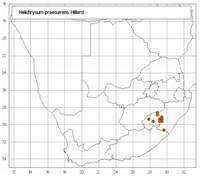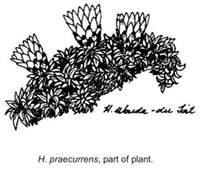Origin of name:
praecurrens = creeping
Diagnostic characters:
MatformingLarge solitary headsWhite / pink bracts
Description:
Densely tufted mat-forming perennial herb, main stems diffuse, prostrate, nude, rooting, producing innumerable erect closely leafy branchlets up to c. 20 mm high. Leaves up to c. 7 x 2 mm, closely imbricate, appearing rosulate from above, linear to narrowly lanceolate, with smooth sericeous 'tissue-paper' indumentum, green with a silvery sheen, drying silvery grey. Heads homogamous or rarely heterogamous, campanulate, c. 10 mm long, nearly double that across the fully radiating bracts, sessile, solitary at the tips of the branches. Involucral bracts in c. 7 series, graded, closely imbricate, outer pellucid, palest brown, inner much exceeding the flowers, white, or tinged or tipped rose-pink, opaque. Receptacle smooth. Flowers 18�24, rarely 1�4 female. Achenes 1.5 mm long, ellipsoid, obscurely ribbed, glabrous or occasionally with a few duplex hairs. Pappus bristles many, equaling corolla, scabrid, bases fused in a smooth ring.
Flowering from November to early December.
Distribution:
Forms dense mats colonizing bare or sparsely grassed areas. On the high Lesotho mountains and on the summit of the high Drakensberg along the KwaZulu-Natal-Lesotho border, always more than 3 000 m above sea level.
Grassland Biome.
Notes:
Can be confused with H. sessilioides but is easily distinguished by its different habit, leaves silky below, not woolly, and different pappus.Taxonomy:
Literature:
Helichrysum praecurrens Hilliard in Notes R. bot. Gdn Edinb. 32: 359 (1973), Compositae in Natal 222 (1977).
Type:
KwaZulu-Natal, Estcourt distr., summit of Drakensberg in vicinity of Giant's Castle Pass, c. 3170 m, Wright 1044 (NU, holo.; E; K; PRE, iso.).
Synonym(s):
Vouchers:
Edwards 349 (NU); Hilliard & Burtt 7098 (E; K; MO; NBG; NU; PRE; S); Wright 339 (E; K; NU; S).

_PRE0212088-Tee_sml.jpg)